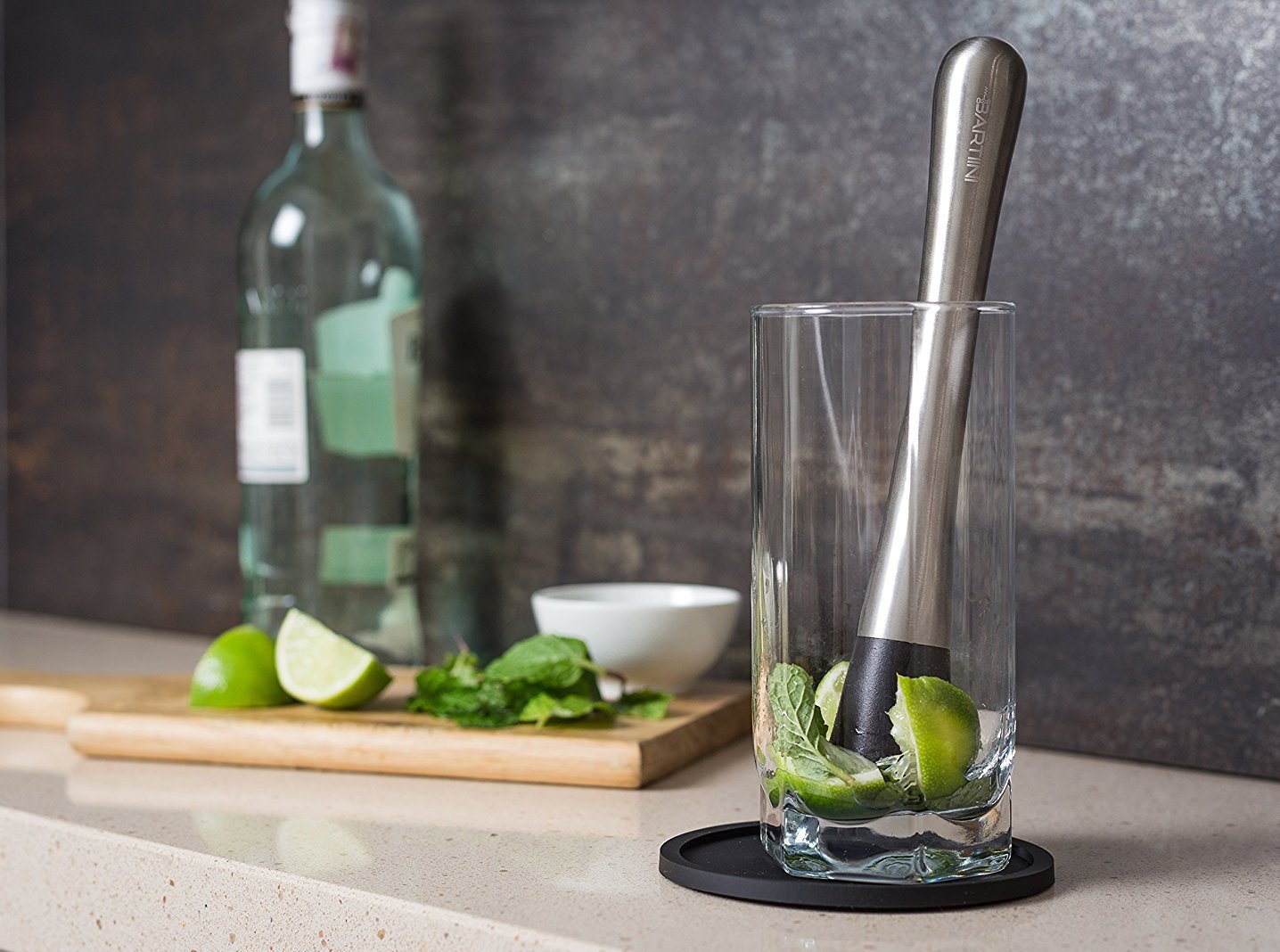Rating of the best heart rate monitors for measuring heart rate variability for 2025

Most scientists believe that the future belongs to preventive medicine: people will be able to detect the first signs of a pre-illness condition in advance and take timely measures, rather than go to the hospital when the body has already had a breakdown, as we do today. This will be helped by devices that can collect and analyze enough health data so that a person can take action before a serious problem arises.
So far this is a dream as accurate measurements are still being made in labs/hospitals using expensive and powerful equipment. However, time and technology do not stand still: more and more indicators that were previously available for analysis only in medical offices can already be collected and calculated using mobile devices.For example, indicators of the HRV methodology, or heart rate variability (in English, heart rate variability, HRV).
HRV-based gadgets and smartphone programs “can decipher” the “Morse code” of pulsograms into dozens of useful information about the degree of stress, tension, the state of the central nervous system and health in general.
Content [Hide]
HRV History
HRV analysis as a methodology emerged in the 1960s. It was developed as a non-invasive method for determining the degree of stress in the body, to assess the working condition, the likelihood of illness, etc.
The period of the emergence of the methodology is not accidental: at first, HRV was used to monitor the health of astronauts, and the methodology developed in parallel with the space programs of the superpowers. Doctors had to control the level of workload of the astronauts in order to prevent the possibility of their illness in conditions of colossal physical and psychological overload in preparation for flights. Already in the 1970s, it became clear that the HRV methodology is applicable in many "earthly" areas: for example, in sports medicine to control the load of athletes before competitions or in industrial medicine to control the stress and health of specialists with an increased area of responsibility (pilots, dispatchers, special forces, etc.)
Today, HRV has become available to almost everyone thanks to "smart" heart rate monitors and services. HRV-based stress and tension indicators are found in gadgets from Apple, Mi, Polar, Suunto, etc.
What is heart rate variability
Let's answer the question: "If the heart beats 60 times per minute, then how much time passes between each contraction?". The correct answer is whatever. For example, 0.95 seconds can pass between 1 and 2 contractions, 1.05 seconds between 2 and 3, and 1 second between 3 and 4.
From the above example, we can conclude the following:
HRV is the change in the time interval between heartbeats.

Photo source: www.engy.app
If the time difference between beats is large (as in the above example), then this is good, since the heart responds to signals from the body. If the heart beats at the same intervals (for example, each beat lasts exactly 1 second), then this is bad. In this case, it is usually said that the variability is very small and the heart does not respond to signals from the body. If the difference in time between beats is too great, this is also bad: the heart cannot stabilize.
Why does the heart beat unevenly?
Everything in our body is interconnected, because the body is a system. The heart is part of this system and responds to changes in the body, including changes in the tension of the nervous system. So, in stress, your heart rate quickens, and in peace or in sleep, it decreases. The sinus node is responsible for the connection between the nervous system and the heart - a nerve clot in the heart that affects the pulse, reacting to signals from the nervous system.
It is important to understand that the nervous system is also, as the name implies, a "system", and it has components.At the most ancient, or autonomic, level of the nervous system, the sympathetic nervous system, which is responsible for the body's response to stress, and the parasympathetic nervous system, which is responsible for restoring the body after stress, stand out.
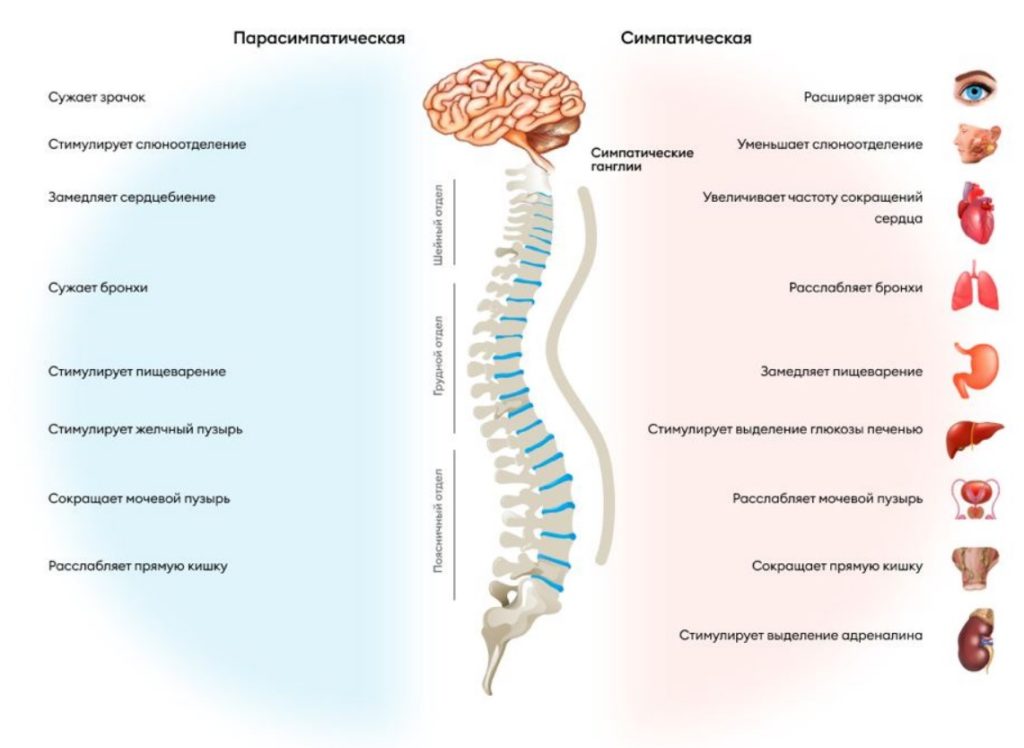
Source: www.engy.app
The sympathetic and parasympathetic nervous systems are autonomous, that is, they are activated without the conscious participation of a person: the sympathetic nervous system makes the heart beat faster when you encounter an angry dog, whether you want it or not.
However, let's do a thought experiment. Let's say you have surgery in a couple of hours. You are afraid to go for it, the signals of the sympathetic system clearly indicate that you do not need to “go under the knife” and endanger the integrity of the body, and the best and most obvious way out of the situation is to simply run away. But you still go for the operation against your instincts. Your motivator is the evolved upper level of the nervous system, or the central nervous system, which is subject to conscious control.
This example shows that signals from the central nervous system can suppress signals from the autonomic nervous system. This structure can be represented as follows:
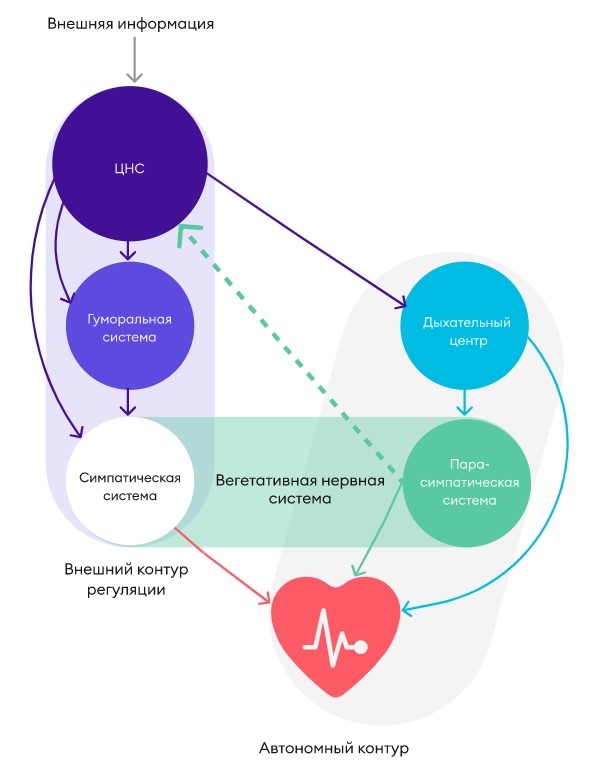
Source: www.engy.app
"Wires" (nerve endings) of the elements of the autonomic and central nervous system are connected to the heart through the sinus node. Cardiologists and physiologists have found a way to analyze the degree of tension in the components of the nervous system using the mathematical transformation of pulsogram data in the framework of the methodology of heart rate variability and calculate the level of stress, tension of the nervous system and other indicators.
Fundamentals of HRV methodology in fitness gadgets
So, what do the parameters “energy” (Total Power in English), “stress” (Stress Index) and “recovery” (RMSSD) mean in fitness devices and is it really possible to calculate the body charge as the battery level on a mobile phone? We will try to explain the mechanics as simply as possible.
HRV calculations are based on the mathematical analysis of variability. AtScientists have noticed that variability is like a wave - periods of low variability will be followed by periods of high variability (just as at sea, periods of strong waves are replaced by periods of weak waves). Having resorted to the subsequent mathematical analysis of the pulsogram waves using the Fourier transform, 3 wave frequencies can be distinguished:
- Short waves (High Frequency Waves, or HF waves). Scientists have found that they give an idea of the functioning of the parasympathetic system, which is responsible for restoring the body after stress. They show the effect of the vagus nerve on the pulse.
- Long waves (Low Frequency Waves, or LF-waves). These waves give an idea of the functioning of the sympathetic system. In the human body, it is responsible for engagement and response to stress.
- Extra long waves (VLF-ln). These waves give an idea of the functioning of the humoral system through hormonal effects associated with the regulation of the body's adaptability when the strength of the sympathetic and parasympathetic is not enough. VLF reflects the degree of CNS involvement and reflects the degree of psychological or emotional overstrain.
Based on the analysis of LF, HF and VLF waves, you can create a spectrogram and see the degree of stress in each of the systems.
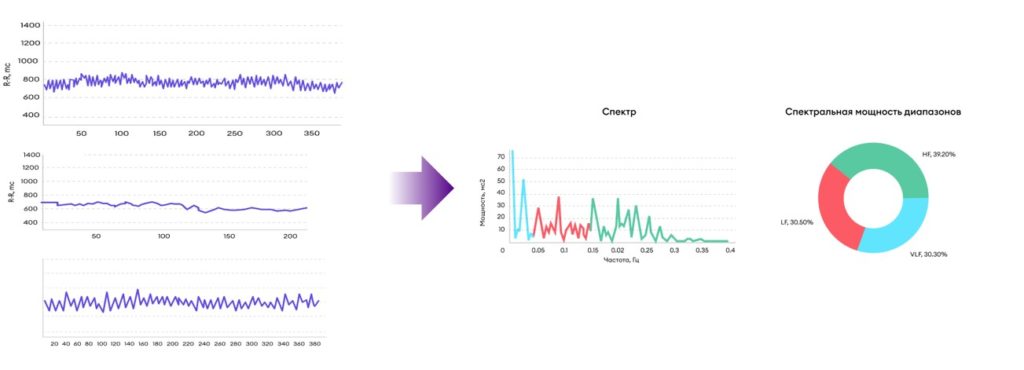
Source: www.engy.app
This means that we can clearly understand which of the systems affects a person during the measurement to a greater extent: sympathetic (stress level), parasympathetic (recovery from a stressful state) or humoral (psychological and intellectual stress).
How to use HRV in life?

Thus, heart rate monitors that support HRV analysis, in addition to calculating the pulse, track the stress state, load and recovery of the human body. This functionality is extremely useful in many areas of life:
- Physical health. HRV analysis allows early detection of nervous system overexertion for preventive control of nervous diseases.
- mental health. Analysis of heart rate variability allows you to track the effectiveness of practices, regimen and load in the field of mental health - yoga, meditation, etc.
- Sport. To correct the load during sports, reduce the likelihood of overtraining, as well as reduce the risk of physiological and nervous breakdowns during the training process. Sports medical research suggests that athletes who use the HRV methodology improve their performance.
- Professional activity. HRV analysis helps reduce the risk of professional burnout, apathy and depression. HR specialists can monitor the status of employees with increased areas of responsibility, top management, etc.
- HLS. HRV analysis allows you to determine the effect of any healthy lifestyle experiments (sleep, diet, physical activity) on the nervous system to adjust the load
In this rating, we reviewed models of heart rate monitors with HRV support for various functionalities, described their features and characteristics. We also took into account the opinion of customers, the popularity of models and their affordability.
Polar H10
votes 4
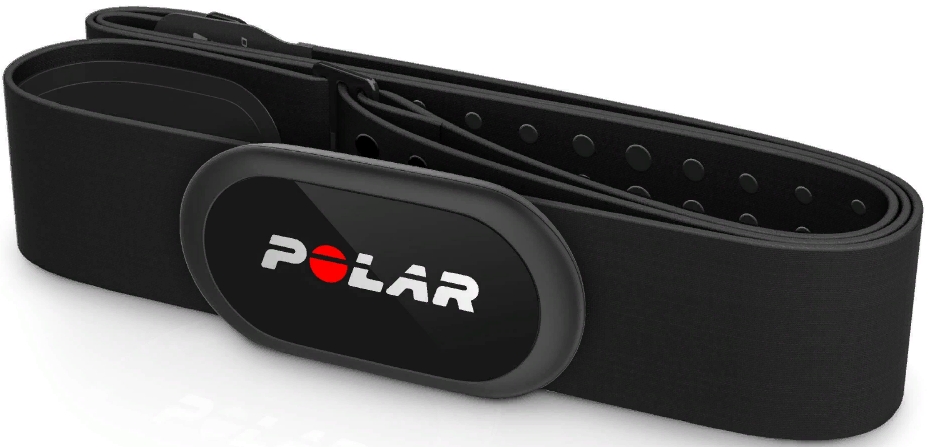
POLAR is a Finnish company with 40 years of experience in manufacturing heart rate sensors for sports. This is one of the most famous brands in the Russian Federation for the production of devices for sports. The model we are reviewing is an improved version of the H7 gadget, which was discontinued last year.
In this device, all swimmers' complaints about the strap have been eliminated. The number of electrodes in this gadget has been increased from 2 to 4 for the most accurate determination of the heart rate. The energy efficiency of the device has increased from 200 (in the H7 model) to 400 hours. This device has successfully implemented support for 4 information transfer technologies:
- Bluetooth smart.
- GymLink - for diving and sports equipment.
- ANT+.
- 3 kHz.
This model can be paired with GoPro cameras. This is the first Polar device to have 30 hours of built-in memory. This means that during this time the gadget can work without a sports watch or fitness bracelets.
Average price: 8990 rubles.
- heart rate control with maximum accuracy;
- the ability to connect the sensor to various devices for training using Bluetooth and ANT +;
- regular software updates;
- soft textile belt;
- quality electrodes.
- not found.
Wahoo TICKR
votes 0
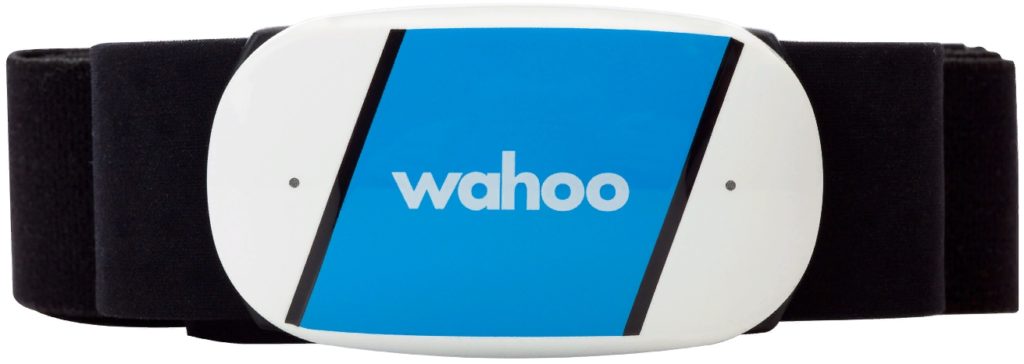
This is a chest gadget designed for accurate measurement of heart rate and pulse control with synchronization with a smartphone or bike computer. It accurately monitors heart rate and calorie consumption for any activity or workout.The sensor works with mobile devices running on iOS and Android operating systems, as well as bike computers via ANT+ and Bluetooth Smart connections. The sensor is attached to the chest with an elastic adjustable strap.
The free Wahoo Fitness app is used to communicate with devices, record and evaluate workout information. The device works with more than 50 programs. The model has a blue and red LED indication to assist with pairing. The sensor is powered by a CR 2032 element, which lasts up to 12 months of use.
Average price: 4590 rubles.
- heart rate control and heart rate measurement;
- data for calculating calories burned;
- small size and light weight;
- simplicity and versatility of fastening on the chest;
- wireless pairing with devices via Bluetooth Smart and ANT +;
- universal use with smartphones and cycle computers;
- two LEDs to help when connecting devices;
- the ability to work with compatible applications from other manufacturers;
- interaction with Apple Watch;
- IPX7 water resistance (immersion in water up to 1.5 meters).
- unusual strap.
Wahoo TICKR X
votes 0
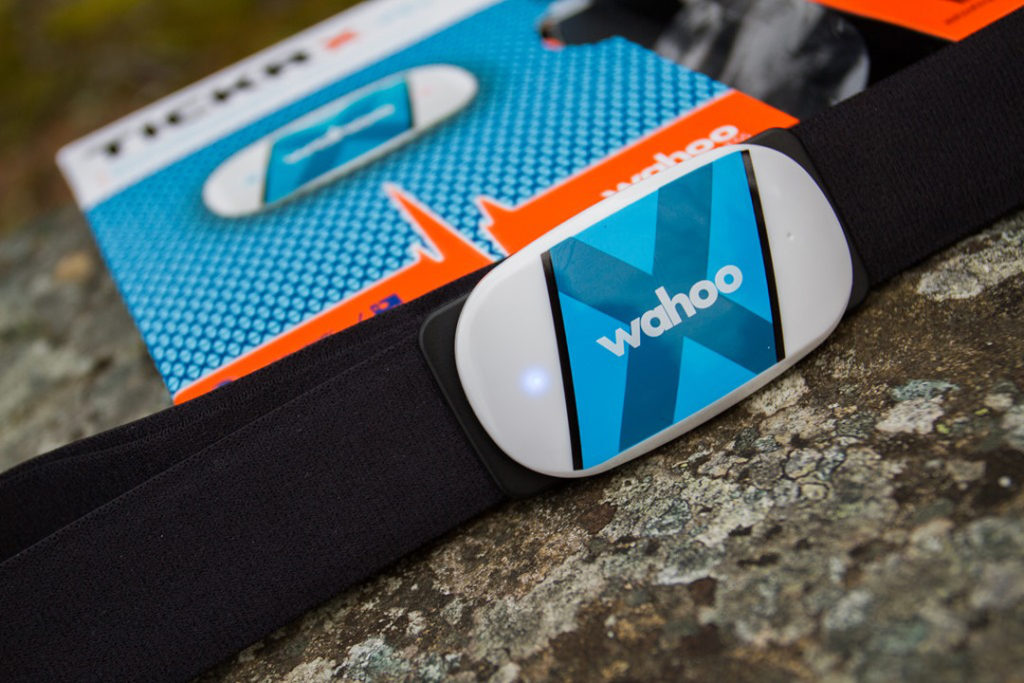
This is a device for calculating the pulse, as well as calories burned in the process of exercising or simply movements per day. This device allows you to monitor health indicators and change the load. The model will be an excellent option for any kind of sport. The device is a soft stretchable belt with a heart rate monitor. The gadget sends the smartphone information about the heart rate, motion analysis, determines the intensity of classes and allows you to set the correct process for performing classes.This model supports Wahoo Burn and Burst Training Program, and also works correctly with iOS or Android devices.
Average price: 6590 rubles.
- instant connection with devices;
- the phone app can send workout workouts to strava;
- high-quality fastening;
- easy to use;
- there are light indicators;
- no low battery indicator.
Garmin HRM Dual
votes 1
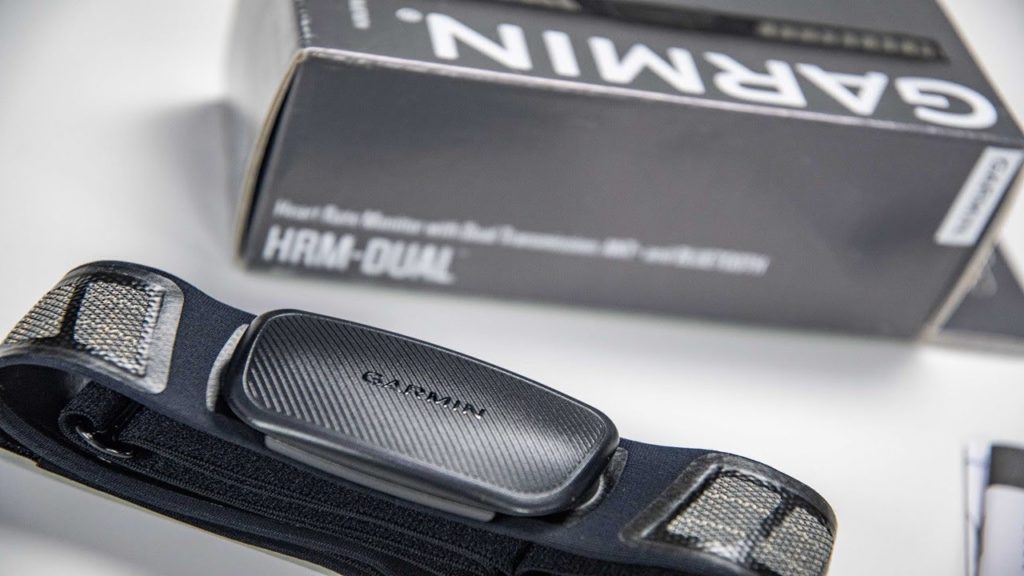
This premium heart rate monitor sends real-time heart rate information via ANT+ and Bluetooth Low Energy, giving the wearer more options for indoor, outdoor and even web activities.
With this model, the user will be able to regularly monitor the exact heart rate on a Garmin device, as well as in online training programs, for example, Zwift, Trainer Road, or on compatible equipment in the gym. No matter which exercise method the user chooses, they will always receive the accurate real-time heart rate data they need to improve their fitness.
This gadget is equipped with an elastic comfortable strap with the ability to adjust. It is also very easy to care for: just remove the heart rate monitor unit and the removable belt can be washed. In addition, the owner no longer needs to think about charging the battery, since its service life is up to 3.5 years.
Average price: 6400 rubles.
- the ability to connect to Garmin watches and cycling computers, to compatible sports equipment, as well as to connect with third-party training applications on phones or tablets;
- accurately and quickly measures the pulse;
- comfortable in using.
- does not connect directly to Garmin Connect.
SUUNTO SMART HEART RATE BELT
votes 0
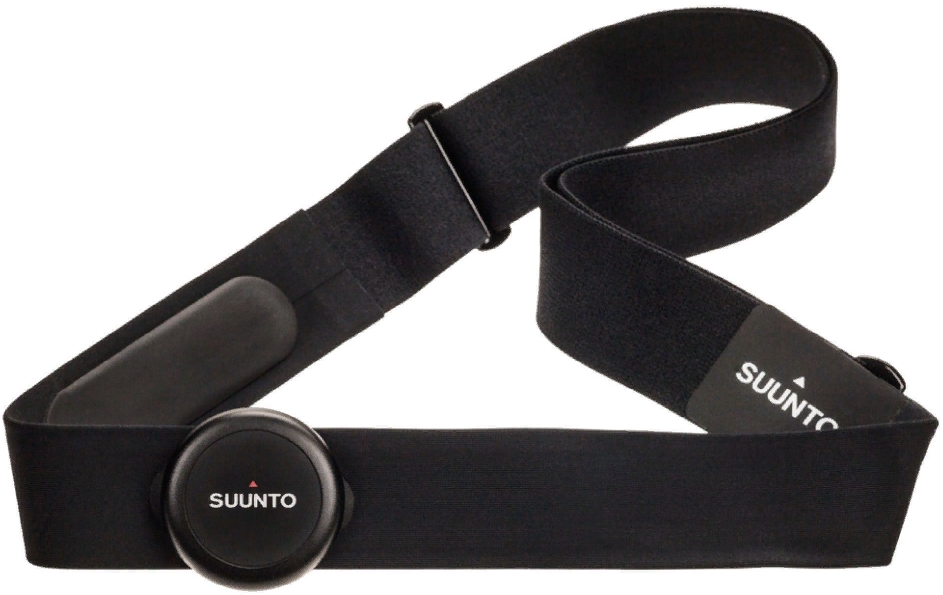
Suunto is a Finnish firm that originally made dive computers and then expanded its products to cover most of the known sports. The advantage of the devices of this company is their suitability for swimming and staying in the water.
When buying a model for calculating heart rate variability, you should take into account the fact that there are 2 more attractive devices in the Suunto line of gadgets: Comfort Belt ANT and Dual Comfort Belt. They are much cheaper than the model we are considering (the price is 700 rubles lower). This device supports work with other devices, in addition, the manufacturer has its own very high-quality Movescount App program.
Average price: 7990 rubles.
- the latest Bluetooth Smart transmission technology
- pairing with smartphones (IOS and Android);
- measuring (recording) the pulse in water;
- the smallest cardiac sensor in the manufacturer's line of devices;
- Compatible with Movescount App and Suunto of the same name.
- not found.
Zephyr HxM
votes 0

This model calculates heart rate with high accuracy, while the owner of the device can see all the information in real time. Reviews about Zephyr are positive: many athletes are convinced of the high quality of the device.
In addition to heart rate, the heart rate monitor also measures RR interval, speed and distance traveled. On the chest of a person, Zephyr (reviews about this method of fastening are only positive) is fixed with a comfortable elastic strap. The binding is machine washable and comes with a 12 month guarantee against defects.If necessary, the belt can be changed.
Average price: 4800 rubles.
- made of electrically conductive materials, which guarantees comfortable use and high measurement accuracy;
- open communication execution;
- compatible with many well-known programs, including Armour39, Endomondo, Strava, SportsTracker, Runtastic, Wahoo Fitness.
- not identified.
Cardiosport TP3
votes 0
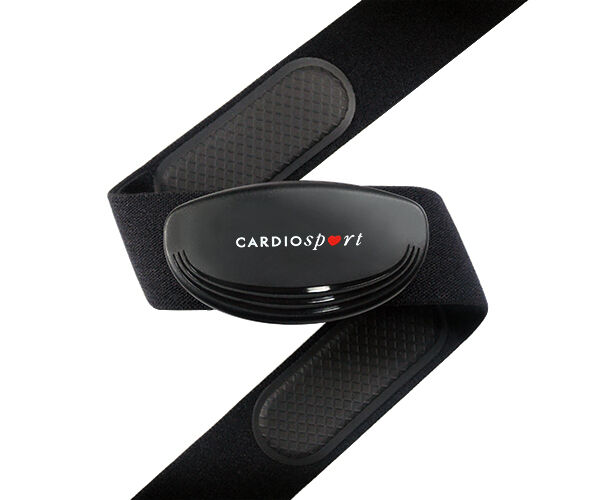
This company has been on the market since 1976. It develops and manufactures heart rate monitors, cycle computers and sensors, fitness bracelets and exercise equipment for a number of popular brands. The company owns an exclusive patent for calculating heart rate in hours. As of 2025, it provides one of the most accurate ECG pulse and heart rate variability systems on the market (the firm claims medical accuracy).
The device is fully compatible with well-known fitness programs such as Zwift, Wahoo Fitness, Kinomap, Peloton, Trainerroad, Map My Run and Polar Beat, ithlete.
Average price: 2650 rubles.
- dual Bluetooth Smart and ANT+ wireless technology;
- high ECG accuracy 99.4%;
- long battery life (up to 900 hours);
- three polymer electrodes are integrated into a soft elastic waistband for maximum comfort;
- advanced calorie counter algorithm based on user settings and exercise intensity;
- medical, corrosion-resistant, stainless steel snap-on poppers connect the transmitter to the strap.
- not identified.
conclusions
Every year, manufacturers of wearable heart rate monitors increase the range and quality of heart rate sensors, regularly increasing the accuracy of the devices.Using the best heart rate monitors presented in our rating, you can be sure of the high quality of HRV measurements using the Engy Heath service.
In this rating, we reviewed models of various functionalities, described their features and characteristics. We also took into account the opinion of customers, the popularity of models and their affordability.
new entries
Categories
Useful
Popular Articles
-

Top ranking of the best and cheapest scooters up to 50cc in 2025
Views: 131651 -

Rating of the best soundproofing materials for an apartment in 2025
Views: 127691 -

Rating of cheap analogues of expensive medicines for flu and colds for 2025
Views: 124519 -

The best men's sneakers in 2025
Views: 124033 -

The Best Complex Vitamins in 2025
Views: 121940 -

Top ranking of the best smartwatches 2025 - price-quality ratio
Views: 114980 -

The best paint for gray hair - top rating 2025
Views: 113395 -

Ranking of the best wood paints for interior work in 2025
Views: 110319 -

Rating of the best spinning reels in 2025
Views: 105330 -

Ranking of the best sex dolls for men for 2025
Views: 104367 -

Ranking of the best action cameras from China in 2025
Views: 102216 -

The most effective calcium preparations for adults and children in 2025
Views: 102011




